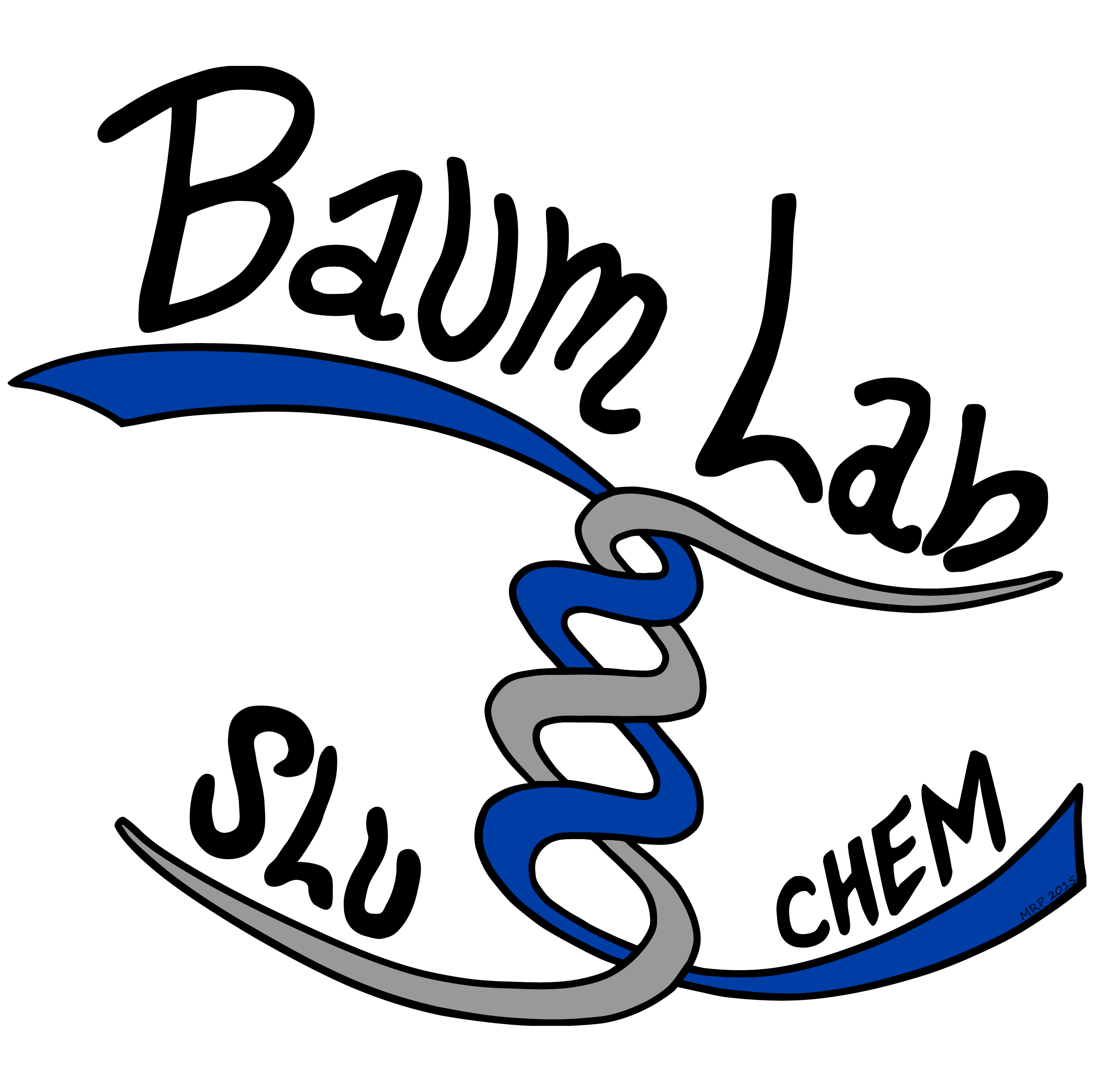
Research
RNA and DNA are well-known for their coding roles within a cell, but in recent years, new roles for nucleic acids have been discovered. Of particular interest are the catalytic abilities of nucleic acids in the forms of ribozymes (catalytic RNA) and deoxyribozymes (catalytic DNA, DNAzymes) and the binding abilities of nucleic acids in the form of aptamers. These nucleic acid enzymes and aptamers have been used in a variety of biochemical applications and are finding new uses in the areas of biotechnology and nanotechnology.
Nucleic acid-based Sensors
One goal of the Baum lab is to use nucleic acids (RNA and DNA) for analytical applications. We are currently identifying aptamers that can be used for detecting small molecules of interest, such as pollutants and pharmaceuticals. We are also using both the catalytic and binding
abilities of nucleic acids to develop aptazymes for use in sensors.
Relevant publications
Samuelian, J. S. & Baum, D. A. (2022) "Identification of DNA Aptamers for Benzodiazepine Detection in Synthetic Urine" Anal. Sens. e202200044. DOI:10.1002/anse.202200044
TeSelle, E. K. & Baum, D. A. (2018) "Isolation of DNA aptamers for herbicides under varying divalent metal ion conditions" Aptamers 2, 82-87. ISSN: 2514-3247
Behera, A. K., Schlund, K. J., Mason, A. J., Alila, K. O., Han, M., Grout, R. L. & Baum, D. A. (2013) "Enhanced deoxyribozyme-catalyzed RNA ligation in the presence of organic cosolvents" Biopolymers 99, 382-391. DOI:10.1002/bip.22191
Alila, K. O. & Baum, D. A. (2011) "Modulation of an RNA-branching deoxyribozyme by a small molecule" Chem. Commun. 47, 3227-3229. DOI:10.1039/C0CC04971A
DNA-based Biomolecule Organization
A significant challenge in several applications is how to organize biomolecules, such as enzymes, in a controlled manner. DNA is a good material for this type of organization because it is readily modified for attachement to surfaces and other biomolecues and the rules for bringing together DNA sequences are well-known because of Watson-Crick basepairing.
Using DNAzymes and readily attainable starting materials, we are forming comb-branched DNA for the directed placement of DNA-tagged biomolecules. The distances between biomolecules is readily adjusted by changing the distances between branch points or the length of the branched strands and we avoid complex chemical synthesis. We have previously demonstrated the utility of comb-branched DNA for single-enzyme immoblization and now are investigating more complex systems.
Relevant publications
Hausmann, N. Z., Minteer, S. D., & Baum, D. A. (2014) "Controlled Placement of Enzymes on Carbon Nanotubes using Comb-Branched DNA" J. Electrochem. Soc. 161, H3001-H3004. DOI:10.1149/2.0011413jes
Nucleic Acids-Redox Cofactor Interactions
Several biological cofactors contain nucleic acid components and interactions between these cofactors and nucleic acids may have been important in the origin of life. We have begun investigating these interactions in the context of DNA aptamers, which could find use in various applications. With support from NASA, we are collaborating with a group led by the Burke Lab to expand these studies with RNA aptamers to investigate how these interactions could have formed ribozymes capable of redox chemistry important for the development of modern metabolism.
Relevant publications
Samuelian, J.S., Gremminger, T.J., Song, Z., Poudyal, R.R., Li, J., Zhou, Y., Staller, S.A., Carballo, J.A., Roychowdhury-Saha, M., Chen, S., Burke, D.H., Heng, X., & Baum, D. A. (2022) "An RNA aptamer that shifts the reduction potential of metabolic cofactors" Nat. Chem. Biol., 18, 1263-1269.DOI:10.1038/s41589-022-01121-4
Emahi, I., Gruenke, P. R., & Baum, D. A. (2015) "Effect of Aptamer Binding on the Electron-Transfer Properties of Redox Cofactors" J. Mol. Evol., 81, 186-193. DOI:10.1007/s00239-015-9707-7
Emahi, I., Mulvihill, I. M., & Baum, D. A. (2015) "Pyrroloquinoline quinone maintains redox activity when bound to a DNA aptamer" RSC Adv., 5, 7450-7453. DOI:10.1039/c4ra11052h
DNA components for Biofuel Cells
Another interest of the Baum Lab is exploring new catalytic activities for DNA that would be of use in areas of science outside of biochemistry. In particular, we have been exploring the abilities of DNA in redox reactions. These studies expand the catalytic repertoire of DNA while providing novel catalytic components for applications, such as biofuel cells. In collaboration with the Minteer group, we demonstrated that a peroxidase deoxyriboyzme can function as a catalyst in a biofuel cell. Our work with cofactor-binding aptamers will serve as a foundation for in vitro selection efforts to identify new redox DNAzymes.
Relevant publications
Zhang, M., Xu, S., Minteer, S. D., & Baum, D. A. (2011) "Investigation of a deoxyribozyme as a biofuel cell catalyst" J. Am. Chem. Soc., 133, 15890-15893. DOI:10.1021/ja206787h
Functional Nucleic Acids for Wound Healing
One of our newest projects is exploring how DNA aptamers can be used to improve wound healing, particularly diabetic wounds. In collaboration with the Shornick Lab and the Sell Lab, we are identifying therapeutic DNA aptamers to replace antibodies in shelf-stable bandages. We are also identifying DNA aptamers to improve immobilization and delivery of therapeutics from biocompatible scaffolds.
Part of SLU Institute for Drug and Biotherapeutic Innovation
Other Projects
We continue to explore other opportunities to use functional nucleic acids in new ways! Watch this space for updates.